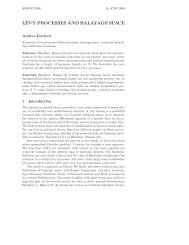Degenerate parabolic stochastic partial differential equations
Degenerate parabolic stochastic partial differential equations
Degenerate parabolic stochastic partial differential equations
Create successful ePaper yourself
Turn your PDF publications into a flip-book with our unique Google optimized e-Paper software.
M. Hofmanová / Stochastic Processes and their Applications 123 (2013) 4294–4336 4311<br />
Moreover, by (14),<br />
t <br />
−E g i (y, y, s) Dσ i (y)z · (∇ϱ)(z) dz dy ds<br />
0 (T N )<br />
2 t <br />
= E g i (y, y, s)div σ i (y) dy ds<br />
0 T N<br />
and accordingly (21) follows.<br />
The last term K is, due to (3), bounded as follows<br />
K ≤ L t<br />
<br />
2 E ϱ τ (x − y)|x − y|<br />
0<br />
(T 2 ψ δ (ξ − ζ ) dν 1<br />
N ) 2 R 2 x,s (ξ) dν2 y,s (ζ ) dx dy ds<br />
+ L t <br />
<br />
2 E ϱ τ (x − y) ψ δ (ξ − ζ )|ξ − ζ |h(|ξ − ζ |)dν 1<br />
0 (T N ) 2 R 2 x,s (ξ)dν2 y,s (ζ )dxdyds<br />
≤ Lt <br />
|x − y| 2 ϱ τ (x − y) dx dy + LtC <br />
ψh(δ)<br />
ϱ τ (x − y) dx dy<br />
2δ (T N ) 2 2 (T N ) 2<br />
≤ Lt<br />
2 δ−1 τ 2 + LtC ψh(δ)<br />
,<br />
2<br />
where C ψ = sup ξ∈R |ξψ(ξ)|. Finally, we set δ = τ 4/3 , let τ → 0 and deduce<br />
<br />
<br />
E f<br />
T ± N 1 (t) f ¯ ± 2 (t) dξ dx ≤ E f 1,0 f¯<br />
2,0 dξ dx.<br />
T<br />
R N<br />
R<br />
Let us now consider f 1 = f 2 = f . Since f 0 = 1 u0 >ξ we have the identity f 0 f¯<br />
0 = 0 and<br />
therefore f ± (1 − f ± ) = 0 a.e. (ω, x, ξ) and for all t. The fact that f ± is a kinetic function and<br />
Fubini’s theorem then imply that, for any t ∈ [0, T ], there exists a set Σ t ⊂ Ω × T N of full<br />
measure such that, for (ω, x) ∈ Σ t , f ± (ω, x, t, ξ) ∈ {0, 1} for a.e. ξ ∈ R. Therefore, there exist<br />
u ± : Ω × T N × [0, T ] → R such that f ± = 1 u ± >ξ for a.e. (ω, x, ξ) and all t. In particular,<br />
u ± = R ( f ± − 1 0>ξ )dξ for a.e. (ω, x) and all t. It follows now from Proposition 3.1 and the<br />
identity<br />
<br />
|α − β| = |1 α>ξ − 1 β>ξ | dξ, α, β ∈ R,<br />
R<br />
that u + = u − = u for a.e. t ∈ [0, T ]. Since<br />
<br />
1 u<br />
±<br />
1 >ξ 1 u ± 2 >ξ dξ = (u± 1 − u± 2 )+<br />
R<br />
we obtain the comparison property<br />
E u ± 1 (t) − u± 2 (t) + <br />
L 1 (T N ) ≤ E (u 1,0 − u 2,0 ) + <br />
L 1 (T N ) .<br />
□<br />
As a consequence of Theorem 3.3, namely from the comparison property (19), the uniqueness<br />
part of Theorem 2.10 follows. Furthermore, we obtain the continuity of trajectories in L p (T N ).<br />
Corollary 3.4 (Continuity in Time). Let u be a kinetic solution to (1). Then there exists a<br />
representative of u which has almost surely continuous trajectories in L p (T N ), for all p ∈<br />
[1, ∞).



